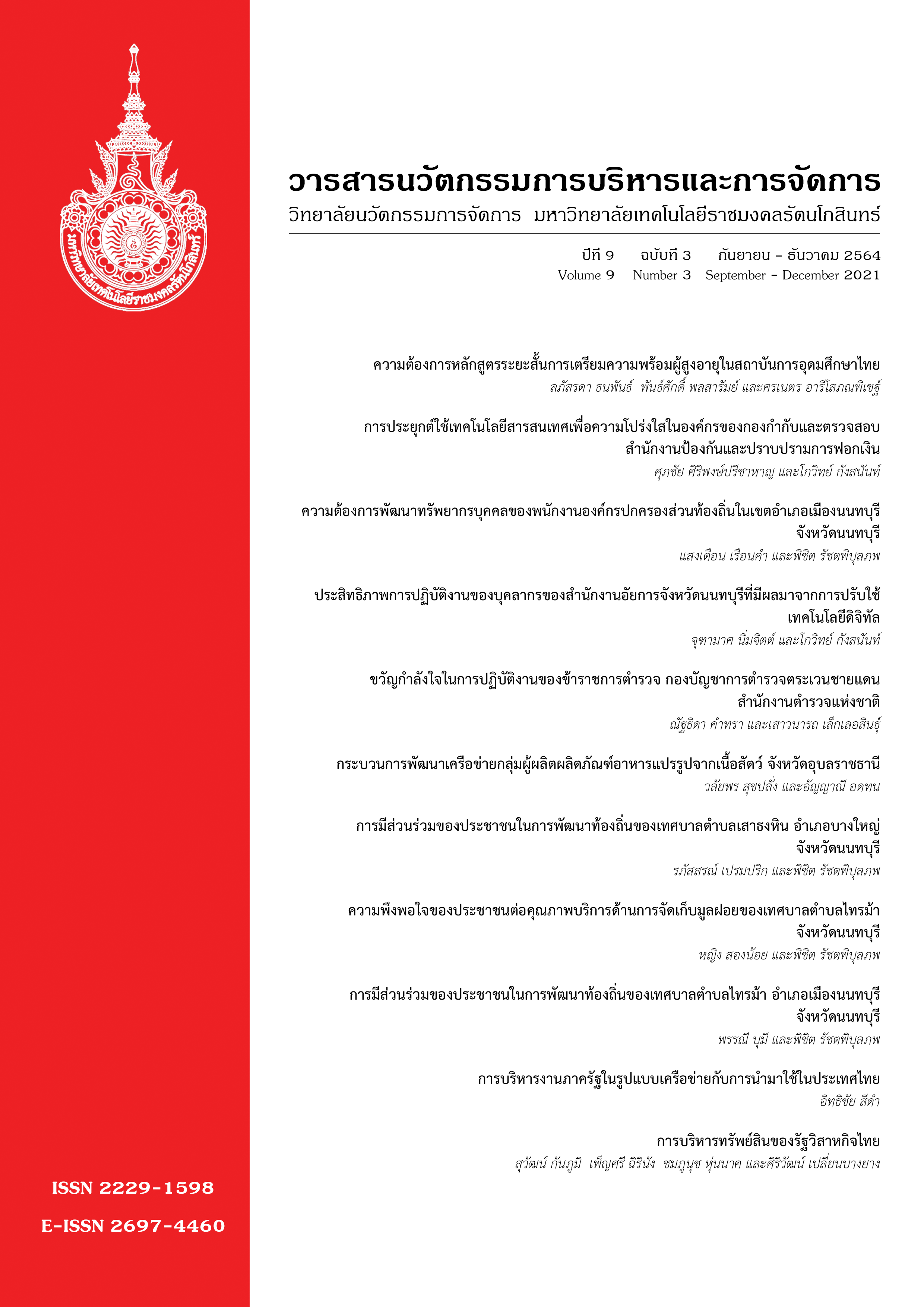การบริหารงานภาครัฐในรูปแบบเครือข่ายกับการนำมาใช้ในประเทศไทย
Main Article Content
บทคัดย่อ
การจัดการภาครัฐในปัจจุบัน คือ การเพิ่มผลผลิตในการบริหารงานภาครัฐ โดยให้ความสำคัญต่อผลสำเร็จของงานเป็นหัวใจหลักสำคัญ เป็นแนวคิดและที่มาของการปฏิรูประบบราชการและการประกาศใช้ระบบการบริหารงานแบบมุ่งผลสัมฤทธิ์ (Result Based Management) ในทศวรรษที่ 1984 การปฏิรูประบบราชการถือว่าเป็นส่วนหนึ่งของการเปลี่ยนแปลงแบบปฏิวัติการบริหารราชการที่เกี่ยวข้องกับ “การปรับกระบวนทัศน์” (Paradigm Shift) จากตัวแบบ ราชการของ Weber ที่มีอิทธิพลมาเกือบศตวรรษ ไปสู่หลัก “การจัดการภาครัฐแนวใหม่” วัตถุประสงค์หลักของ การจัดการภาครัฐแนวใหม่ คือ การปรับปรุงประสิทธิภาพของภาคราชการ ดังนั้นทำให้หน่วยงานภาครัฐของทุกประเทศมีความกระตือรือร้นที่จะปรับเปลี่ยนกระวนการทำงานของตนเองให้สอดคล้องกับการเปลี่ยนแปลง การที่องค์กรภาครัฐจะดำเนินการต่าง ๆ โดยองค์กรแบบปิดหรือองค์กรเดี่ยวไม่สามารถที่จะตอบสนองต่อความต้องการของประชาชนได้ ดังนั้นภาครัฐจึงจะต้องหาวิธีการหรือกระบวนการที่มีประสิทธิภาพในการบริหารจัดการเพื่อส่งมอบบริการแก่ประชาชน ซึ่งวิธีการที่มีความเป็นไปได้และดีที่สุดวิธีการหนึ่งก็คือ การสร้างพันธมิตรในการทำงาน หรือเรียกอีกอย่างหนึ่งว่า “การทำงานแบบเครือข่าย” ซึ่งกำลังได้รับความนิยมจากหน่วยงานของรัฐในทั่วทุกมุมโลก ดังนั้นบทความนี้จึงจะเป็นบทความที่จะนำเสนอเกี่ยวกับแนวคิด ที่มาของการบริหารงานภาครัฐแบบเครือข่าย รวมถึงแนวทางในการนำการบริหารงานภาครัฐแบบเครือข่ายมาใช้ในประเทศไทย
Article Details
ข้อความและบทความในวารสารนวัตกรรมการบริหารและการจัดการ เป็นแนวคิดของผู้เขียน ไม่ใช่ความคิดเห็นและความรับผิดชอบของคณะผู้จัดทำ บรรณาธิการ กองบรรณาธิการ วิทยาลัยนวัตกรรมการจัดการ และมหาวิทยาลัยเทคโนโลยีราชมงคลรัตนโกสินทร์
ข้อความ ข้อมูล เนื้อหา รูปภาพ ฯลฯ ที่ได้รับการีพิมพ์ในวารสารนวัตกรรมการบริหารและการจัดการ ถือเป็นลิขสิทธิ์ของวารสารนวัตกรรมการบริหารและการจัดการ หากบุคคลใดหรือหน่วยงานใดต้องการนำทั้งหมดหรือส่วนหนึ่งส่วนใดไปเผยแพร่ต่อหรือกระทำการใดๆ จะต้องได้รับอนุญาติเป็นลายลักษณ์อักษรจากวารสารนวัตกรรมการบริหารและการจัดการก่อนเท่านั้น
เอกสารอ้างอิง
จิรประภา อัคบวร และประยูร อัคบวร. (2552). การบริหารงานภาครัฐในรูปแบบเครือข่าย = Governing by Network. กรุงเทพฯ: กลุ่มพัฒนาระบบบริหาร สำนักงานคณะกรรมการพัฒนาระบบราชการ.
Alter, C., & Hage, J. (1993). Organizations working together. Newbury Park, CA: Sage.
Ansell, Chris, and Alison Gash. (2008). Collaborative governance in theory and practice. Journal of Public Administration Research and Theory, 18.
Emerson, Kirk, and Peter Murchie. (2010). Collaborative governance and climate change: Opportunities for public administration. In The future of public administration, public management, and public service around the world: The Minnowbrook perspective, eds.
Emerson, Kirk, Tina Nabatchi, Stephen Balogh. (2011). An Integrative Framework for Collaborative Governance. Journal of Public Administration Research and Theory, 22(1).
Gerlach, M. L., & Lincoln, J. R. (1992). The organization of business networks in the United States and Japan. In N. Nohria & R. G. Eccles (Eds.), Networks and organizations: Structure, form, and action. Boston: Harvard Business School Press.
Goldsmith, Stephen and William D. Eggers. (2004). Governing by Network. D.C.: Brookings Institution Press.
Granovetter, M. (1994). Business groups. In N. J. Smelser & R. Swedberg (Eds.), The handbook of economic Sociology. Princeton, NJ: Princeton University Press.
Granovetter, M. (1995). Case revisited: Business groups in the modern economy. Industrial and Corporate Change.
Kreiner, K., & Schultz, M. (1993). Informal collaboration in R & D: The formation of networks across organizations. Organization Studies.
Larson. A, (1992). Network dyads in entrepreneurial settings: A study of the governance of exchange relationships. Administrative Science Quarterly, 37.
Liebeskind, J. P., Oliver, A. L., Zucker, L., & Brewer, M. (1996). Social networks, learning, and flexibility: Sourcing scientific knowledge in new biotechnology firms. Organization Science, 7.
Miles, R. E., & Snow, C. C. (1986). Organizations: New concepts for new forms. California Management Review, 28(3).
Miles, R. E., & Snow, C. C. (1992). Causes of failures in network organizations. California Management Review, 34(4).
Powell, W. W., (1990). Neither market nor hierarchy: Network forms of organization. In B. Staw & L. L. Cummings (Eds.), Research in organizational behavior, Greenwich, CT: JAI Press.
Wright, Deil S., (1974). Intergovernmental Relation An Analysis Overview, in Shafritz, Jay M. & Hyde Albert C. (2007) Classic of Public Administration. Wadsworth: Cengage Learning.


